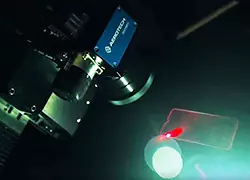Precision Motion Controller: Key Insights & Applications
Precision Motion Controller A precision motion controller is the central computing engine designed specifically to meet the stringent demands of...
Work with our team to determine which products or systems are the best fit for your application.
Some Aerotech products are available for immediate order in North America through our partner Motion Plus.

A case study examining display production that optimizes quality and throughput – and lower total cost.
Motion control is a specialized field within automation engineering that focuses on the coordinated, controlled movement of mechanical systems. At its core, it is the technology and methodology used to manage the velocity, acceleration and specific final position of a machine component, often referred to as a payload or workpiece. This discipline is the bridge between a high-level digital command (e.g., "move to position X, Y") and the precise physical execution of that command by mechanical hardware. Its applications span nearly every industry that requires automated manipulation or high-speed manufacturing processes. When these requirements are taken to the highest level of performance, the discipline is known as precision motion control, which is indispensable for producing highly intricate components and advanced technological systems.
Motion control systems operate based on the fundamental principle of closed-loop feedback. The process begins in the motion controller, which first interprets the desired move command and generates a time-based trajectory, defining the required path, speed profile, and target position. This trajectory is transmitted as a low-power signal to the drive (or amplifier). The drive then converts this signal into a high-power current that energizes the actuator, typically a servo or stepper motor, to initiate movement.
To ensure the actual movement aligns precisely with the planned trajectory, a feedback system is deployed. This system uses sensors such as encoders, resolvers or laser interferometers to continuously measure the motor's actual position and velocity. This real-time data is streamed back to the servo drive, where an error calculation is performed against the target trajectory. This error is processed by the control loop (e.g., a PID controller) to generate a corrective signal, closing the loop and allowing the system to compensate for friction, external disturbances and load changes. The integration of these motion control devices is essential for precise operations, transforming simple movement into a highly controlled, repeatable process.
A motorized stage is a high-precision positioning platform designed to execute highly controlled movement along one or more linear or rotational axes. Structurally, it consists of several key components:
Base
Moving carriage
Precision bearing elements
Drive mechanism (such as a linear motor, ballscrew or worm gear)
High-resolution feedback devices
The term "motorized" simply indicates that an electric motor is integrated into the mechanism to convert electrical energy into mechanical movement, allowing for automated and programmable positioning.
These stages are critical components in a wide array of demanding applications, including optical alignment, semiconductor inspection, laser micromachining and advanced test and measurement setups. They are specifically engineered to minimize structural error motions (like pitch, yaw and roll) and ensure the position of the payload is determined primarily by the feedback sensor. For multi-axis applications requiring simultaneous, highly accurate movement in a plane, a high precision XY stage is a common type of motorized stage that uses two linear stages mounted orthogonally to provide deterministic positioning in two dimensions.
In the context of a control system, precision is the measure of the system's ability to repeatedly and accurately achieve a commanded position or path. It is defined by several key metrics:
Accuracy (how close the actual position is to the target position)
Repeatability (the consistency of returning to the same position under the same conditions)
Resolution (the smallest incremental movement the system can detect or execute)
Achieving high precision requires a holistic precision motion engineering approach, integrating high-resolution feedback devices (like interpolated optical encoders), deterministic mechanical design and advanced control algorithms (like feedforward and advanced PID control) to effectively reject disturbances. High precision is crucial for industries where component tolerance is measured in sub-micron or nanometer ranges. Examples include the fabrication of micro-electronic devices; surgical robotics and medical device manufacturing; advanced automated packaging; and semiconductor defect inspection systems, where not achieving target specifications can lead to costly material waste or product failure. These precision motion engineering systems are designed for high accuracy to ensure the end product adheres to the most stringent quality standards.
Have questions about precision motion control? Ask our experts!
Precision Motion Controller A precision motion controller is the central computing engine designed specifically to meet the stringent demands of...
The fundamental principle of a servo motor is closed-loop feedback control. This mechanism allows the motor system to continuously measure its actual...
1 min read
Motion Controller Programming Motion controller programming is the foundational activity that translates a machine's intended function—whether that...